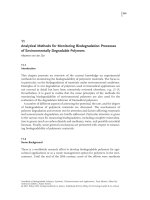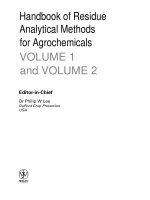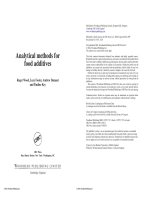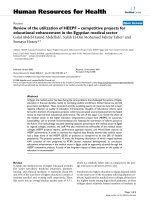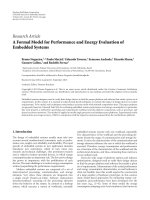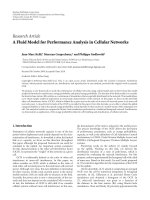Analytical methods for performance enhancement in unreliable multistage manufacturing systems with imperfect production
Bạn đang xem bản rút gọn của tài liệu. Xem và tải ngay bản đầy đủ của tài liệu tại đây (4.59 MB, 195 trang )
ANALYTICAL METHODS FOR PERFORMANCE
ENHANCEMENT IN UNRELIABLE MULTISTAGE
MANUFACTURING SYSTEMS WITH IMPERFECT
PRODUCTION
CHEN RUIFENG
(B.Eng.)
A THESIS SUBMITTED
FOR THE DEGREE OF DOCTOR OF PHILOSOPHY
DEPARTMENT OF MECHANICAL ENGINEERING
NATIONAL UNIVERSITY OF SINGAPORE
2010
i
Acknowledgements
A simple thank you seems inadequate to represent my deep appreciation and
gratitude for all the people who have shared part of my life during my PhD
experience. I have learned as much from each of you as I have from all the
courses I have taken and the books I have read.
First and foremost, I am profoundly grateful for the support,
encouragement, and guidance of my advisor, Professor V. Subramaniam.
From concept to production of this work, Professor V. Subramaniam has
guided, challenged, and encouraged me in innumerable ways. He gave me the
freedom to explore the research problems using various methods. I have
learned immensely from the weekly (and sometimes even daily) discussions
with Professor V. Subramaniam and this is helpful not only in the research but
also for my future career.
I would also like to thank the National University of Singapore for
offering me the research scholarship, research facilities, and valuable courses.
Without this support, my graduate study will not have been as fruitful as it has
been in the past five years.
I want to thank European Aeronautic Defence and Space Company
(EADS) Singapore, for providing me with a valuable opportunity to work with
their research group. This experience has broadened my horizon, and enriched
my knowledge, especially on data processing. Special thanks go to Dr. David
Woon, who offered helpful suggestions and kindly support in my research.
ii
Expressed thanks are also due to my colleagues in the research group,
Yang Rongling, Lin Yuheng, Cao Yongxin, Chanaka Dilhan Senanayake, and
S.P. Singh. My gratitude is also extended to the friends in National University
of Singapore, Huang Weiwei, Zhu Kunpeng, Weng Yulin, Zhou Longjiang,
Feng Xiaobing, Chao Shuzhe, Yin Jun, Han Dongling, Wei Wei, Wan Jie,
Zhao Guoyong, Kommisetti V. R. S. Manyam, and many others, for their
enlightening discussion and suggestions.
I owe my deepest thanks to my family for the unconditional and selfless
support. My parents have provided me with a lifetime of example for
everything that I have done. My attempt to be as good and wise as them is all I
can do in return. To my parents in laws, their encouragement in so many ways
has made this journey easier. Last but not least, I would like to thank my wife,
Li Lin, who has been patient, understanding, helpful, and insightful. She has
reminded me to follow my heart and chase dreams, and inspired me to achieve
more.
iii
Table of Contents
Acknowledgements i
Table of Contents iii
Summary vi
List of Tables viii
List of Figures x
Chapter 1. Introduction 1
1.1. Research Background 1
1.1.1. Machine Deterioration and Strategy for Improving System
Reliability 5
1.1.2. Imperfect Production and Solution for Quality Improvement 7
1.2. Motivation 9
1.3. Thesis Outline 13
Chapter 2. Performance Evaluation and Enhancement of Multistage
Manufacturing Systems: a State of the Art 14
2.1. Overview 14
2.2. Performance Measures of Manufacturing Systems 14
2.3. Analytical Models for Performance Evaluation of Multistage
Manufacturing Systems 18
2.4. Analytical Studies of Manufacturing Systems with Unreliable
Machines and Preventive Maintenance 23
2.5. Analytical Studies of Manufacturing Systems with Imperfect
Production and Quality Inspection 25
Chapter 3. Performance Enhancement of Multistage Manufacturing
Systems with Unreliable Machines 30
3.1. Overview 30
3.2. Definition of Notations 31
3.3. Model Development 34
3.3.1. A 2M1B Line with Machine Deterioration and Preventive
Maintenance 34
3.3.2. Assembly Lines with Preventive Maintenance 41
3.3.3. Performance Measures 48
3.4. An Application of the Model: Determining the Frequency of
Preventive Maintenance for Improving Production Rate 50
3.5. Model Validation 55
iv
3.5.1. Convergence of the Decomposition Algorithm 55
3.5.2. Model Validation in Systems with Homogeneous Machines 55
3.5.3. Model Validation in Systems with Non-homogeneous Machines
59
3.6. A Case Study for Determining the Maintenance Rate of Each
Machine in an Assembly Line 61
3.7. Impact of Costs and Buffer Sizes on Preventive Maintenance: A
Numerical Study 65
3.8. Numerical Comparison of the Decomposition and Single-Machine
Models 68
3.9. Analyzing CPU time and Accuracy of the Decomposition Model 69
3.10. Extension of the Model for Incorporating Machine State Inspection
72
Chapter 4. Performance Enhancement of Multistage Manufacturing
Systems with Imperfect Production 78
4.1. Overview 78
4.2. Definition of Notations 79
4.3. Model Development 81
4.3.1. Quality of Material Flow 84
4.3.2. Decomposition of Assembly Lines 86
4.3.3. Deriving Balance Equations for the Primitive Line Segment 88
4.3.4. Performance Measures 92
4.4. Inspection Allocation in Assembly Lines 94
4.5. Model Validation 99
4.6. Comparison with the Model of Penn and Raviv (2007, 2008) 103
4.7. A Case Study for Determining the Location of Inspection Machines
106
4.8. Sensitivity Analysis of the Model 111
Chapter 5. Modeling of Multistage Manufacturing Systems with Batch
Operations and Generally Distributed Processing Times 113
5.1. Overview 113
5.2. Modeling Multistage Manufacturing Systems with Batch Operations
and Hypoexponential Processing Times 115
5.2.1. Markov Model of a Primitive Line Segment 118
5.2.2. Incorporating the “pseudo down” state in the Primitive Line
Segment 122
5.2.3. Performance Measures 124
5.2.4. Unreliability of Machines 125
5.3. Model Validation 125
5.4. A Case Study for Determining Batch Size of Machines 133
v
Chapter 6. Future Research Opportunities 137
6.1. Overview 137
6.2. Preventive Maintenance with Variable Machine State Inspection Rate
137
6.3. Preventive Maintenance with Consideration of Inventory 139
6.4. Imperfect Production and Repair or Rework of Defective Parts 140
6.5. Performance Enhancement of other Complex Multistage
Manufacturing Systems 141
6.6. Modeling Manufacturing Systems with Uncertain Supply 142
6.7. Integration of Multi-factory Manufacturing Systems 144
Chapter 7. Conclusions 146
Bibliography 150
Appendix A. Balance Equations of the 2M1B Line with Machine
Deterioration and Preventive Maintenance 164
Appendix B. Decomposition Algorithm 169
Appendix C. Using Effective Processing Times to Incorporate Machine
Failures 180
vi
Summary
To confront the fierce international and domestic competition, manufacturing
companies are endeavoring to increase production rate, improve
manufacturing quality, reduce inventory, cut down operational costs, and
hence maintain competitive standing in the market. Performance enhancement
is challenging in a multistage manufacturing system, because of the complex
configuration and various uncertainties in the system. This thesis details a
modeling framework for performance analysis of multistage manufacturing
systems. This modeling framework characterizes the uncertain properties of
manufacturing systems that undermine system performance, in particular: 1)
machines are unreliable and may experience deterioration; 2) production is
imperfect and defective parts are generated randomly.
The modeling framework can be used to estimate a variety of quantitative
and qualitative performance measures. These estimates may enable one to
assess and improve the management of a multistage manufacturing system. A
managerial issue investigated in this research is preventive maintenance,
which is widely implemented in manufacturing systems for improving
machine reliability. Although analytical models of single or two-machine
systems with preventive maintenance have been proposed in the literature,
similar study on multistage systems remains limited. Based on the modeling
framework, the author presents an algorithm to determine the frequency of
preventive maintenance on each machine of a multistage manufacturing
system. Performing preventive maintenance at the frequency prescribed by
vii
the algorithm may avoid excessive or insufficient maintenance, resulting in
improved production rate.
In addition to machine unreliability, imperfect production may also
substantially increase the cost of a manufacturing system. In order to mitigate
the corrupting effects of defective parts generated due to imperfect production,
the quality inspection of the multistage manufacturing system is also
investigated in this thesis. An algorithm is formulated for determining the
placement of inspection machines in such a system. With the inspection
allocation scheme indicated by this algorithm, the quality of material flow in
the multistage manufacturing system is improved. This may reduce the waste
on processing defective parts and penalty resulting from defective parts
shipped to customers.
Based on the modeling framework, the author further explores the
extension for multistage manufacturing systems with batch operations and
generally distributed processing times. This extension makes it possible to
model a wider range of real manufacturing systems.
Keywords: Multistage Manufacturing Systems; Quantity and Quality
Performance; Preventive Maintenance; Inspection Allocation;
Batch Operations; Decomposition
viii
List of Tables
Table 3.1. Balance equation groups based on γ
1
and γ
2
. 39
Table 3.2. Comparison of performance measures and CPU times between
decomposition model and simulation for homogeneous systems 58
Table 3.3. Processing rate and deteriorate rate of each machine in Case D 59
Table 3.4. Processing rate and deteriorate rate of each machine in Case E 59
Table 3.5. Processing rate and deteriorate rate of each machine in Case F 60
Table 3.6. Comparison of performance measures and CPU times between
decomposition model and simulation for non-homogeneous systems 60
Table 3.7. Numerical results in the experiment for determining the frequency
of preventive maintenance 64
Table 3.8. The maintenance rates of machines and buffer sizes obtained from
Case I 67
Table 3.9. Maintenance rates and performance measures determined using the
decomposition and single-machine models 69
Table 3.10. The inspection rate of each machine and profit of the system under
different TH
k
. 77
Table 4.1. The processing or inspection rate for machines in Case E 100
Table 4.2. The processing or inspection rate for machines in Case F 100
Table 4.3. Comparison of results from the integrated quantitative and
qualitative model and simulation 102
Table 4.4. Parameters of the machines in Case G 104
Table 4.5. Parameters of the machines in Case H 105
Table 4.6. Comparison of results obtained using three methods: enumeration,
inspection allocation algorithm (IAA), and Genetic Algorithms (GA) 110
ix
Table 5.1. Organization of Cases A to J 127
Table 5.2. The batch size of each machine in the experiments 127
Table 5.3. Experimental parameters for Cases A to J 128
Table 5.4. Comparison of performance measures and CPU times between
decomposition model and simulation 131
Table 5.5. Parameters for the application problem 135
Table 5.6. Solutions for Q
3
and Q
6
136
x
List of Figures
Figure 1.1. Uncertainty in a manufacturing system 3
Figure 1.2. A typical example of a multistage manufacturing system: the
automotive assembly system 4
Figure 1.3. A typical application of the model in the management of
manufacturing systems 5
Figure 1.4. The effect of preventive maintenance 7
Figure 1.5. The effect of inspection 9
Figure 2.1. An important task in managing manufacturing systems is to predict
system performance 15
Figure 2.2. The relative concentration of inventory investment in three
Canadian industries 17
Figure 2.3. Two representative multistage manufacturing systems 19
Figure 3.1. An appropriate preventive maintenance frequency may minimize
production interruptions due to maintenance or machine failures, resulting in
high machine reliability. 31
Figure 3.2. Multistage manufacturing systems. 37
Figure 3.3. Transitions of machine states (γ
k
) due to deterioration and
preventive maintenance 38
Figure 3.4. Transition diagrams for state (x
1
,γ
1
,γ
2
) 41
Figure 3.5. Decomposing an assembly line into primitive line segments. 43
Figure 3.6. The interpretation of the “pseudo down” state 44
Figure 3.7. The relationship between expected profit, revenue, and cost factors
55
Figure 3.8. The production lines in the experiments 57
xi
Figure 3.9. The production lines in the experiments 59
Figure 3.10. The assembly line studied in the experiment 62
Figure 3.11. The probability of machine failure (Prob(Down)) of Case G, and
the probability of machine failure (Prob(Down)) and preventive maintenance
(Prob(PM)) of Case H. 64
Figure 3.12. Production rate vs. π
3
and π
7
65
Figure 3.13. Profit and costs of the assembly line under two conditions: 1)
maintenance rate and buffer size are chosen as in Case I; 2) maintenance rate
and buffer size are chosen as in Case H 67
Figure 3.14. CPU time of the decomposition model vs. the number of
machines and number of upstates 72
Figure 3.15. CPU time of the simulation per run vs. the number of machines
and number of upstates 72
Figure 3.16. Absolute relative difference between the decomposition model
and simulation vs. the number of machines and number of upstates. 72
Figure 3.17. Machine state inspection and preventive maintenance. 74
Figure 3.18. The inspection rate (λ
k
) of each machine under four conditions,
viz.
k
TH
=1,
k
TH
=2,
k
TH
=3, and
k
TH
=4,
1,2, ,kK
. 76
Figure 4.1. An important cause of profit loss: imperfect production 79
Figure 4.2. An assembly line with inspection machines 85
Figure 4.3. Quality of material flow before and after each machine 86
Figure 4.4. Quality of material flow in the assembly line 86
Figure 4.5. Transition diagrams for state (x
k
,1,1,1,1) 91
Figure 4.6. Possible locations for placing inspection machines 95
Figure 4.7. The assembly lines studied in the experiments 101
Figure 4.8. Finite demand is approximated as an additional machine. 104
xii
Figure 4.9. Configurations of the systems studied in the experiment 105
Figure 4.10. The relative difference between the total inventory obtained using
the analytical models and simulation 106
Figure 4.11. The assembly lines studied in Cases I and J. 108
Figure 4.12. Placement of inspection machines prescribed by the inspection
allocation algorithm 110
Figure 4.13. The fraction of defective parts in the flow rate out of each
processing machine, under three conditions: ubiquitous inspection; inspection
machines are placed as prescribed by the inspection allocation algorithm; and
no inspection 110
Figure 4.14. Percentage of profit improvement if the defective rate of a
processing machine is reduced by 5% 112
Figure 5.1. Manufacturing systems with single-item and batch operations 114
Figure 5.2. A multistage manufacturing system with batch processing
machines 115
Figure 5.3. A machine modeled as a series of virtual stages 118
Figure 5.4. The line segment with processing times characterized as a
hypoexponential distribution 119
Figure 5.5. Transition diagrams for states when
uu
kk
jJ
and
dd
kk
jJ
122
Figure 5.6. The average inventory in each machine and its immediately
downstream buffer for machines M
1
to M
9
in Cases A to C (with lognormal
processing times). 132
Figure 5.7. The manufacturing system studied in the example 135
Figure 5.8. Production rate and profit per minute under different batch sizes
136
Figure 6.1. Preventive maintenance with constant machine state inspection rate
138
xiii
Figure 6.2. Preventive maintenance with variable machine state inspection rate
139
Figure 6.3. A production line where defective parts are repaired. 140
Figure 6.4. A production line where defective parts are reworked. 140
Figure 6.5. Reentrant system 141
Figure 6.6. Disassembly line 142
Figure 6.7. The supplier-buffer-machine line segment 143
Figure 6.8. The logistics cost vs. total sales in an average manufacturing
company (2008) 143
Figure 6.9. A multi-factory manufacturing system 145
Figure B.1. A portion of the assembly line in Figure 3.5 and the corresponding
primitive line segments. 170
1
Chapter 1.
Introduction
1.1. Research Background
Uncertainty associated with production activities has long been considered to
be the “enemy of manufacturing management” (Gershwin, 2009). A
manufacturing system may experience various uncertain events (Liberopoulos
et al., 2006): machines may deteriorate and break down; defective parts may
be generated; inspection errors may occur; machine processing times may vary;
demand may fluctuate; raw material supply may be delayed; etc (some
commonly observed uncertain characteristics of manufacturing systems are
summarized in Figure 1.1). Due to the uncertainty, manufacturing systems
rarely perform exactly as expected, and this substantially complicates the
decision-making in the control and configuration of such systems.
Manufacturing systems may be roughly divided into two groups: single
stage systems and multistage systems. Single stage systems are usually used
in the manufacturing of relatively simple products. Multistage systems, on the
other hand, integrate a number of manufacturing stages (i.e. machines) to
fabricate products with high complexity. The automotive assembly system
illustrated in Figure 1.2 is one typical example of the multistage
manufacturing system, which consists of hundreds of machines with various
functionalities (Sakai and Amasaka, 2007). Compared with single stage
2
systems, the impact of uncertainty in multistage manufacturing systems is
much more complex and unpredictable, because machines are influenced by
each other. For instance, the failure of a machine may induce material
starvation of its downstream machines, and hence interrupt their production.
To mitigate the corrupting effects of uncertainty on a system, an analytical
model for performance evaluation is beneficial. Such a model may provide
useful insights for improving the management of manufacturing. As
illustrated in Figure 1.3, an analytical model of the multistage manufacturing
system may allow a line manager to evaluate various alternate options to
configure a system (for example, one such configuration problem is to
determine the size of each buffer in the system (Li and Meerkov, 2009)).
Based on the performance measures provided by the model, the manager may
identify the best option, and subsequently implement it in the real system.
This practice may result in improved system performance.
In this thesis, the author investigates the multistage manufacturing system
with unreliable machines (machines may deteriorate and break down) and
imperfect production (defective parts are generated). This research provides
the analysis for investigating the influence of production reliability and quality
on system performance. Based on the proposed models, methods for
enhancing the quantitative and qualitative performance of the multistage
manufacturing system are also explored. Preventive maintenance (a widely
implemented strategy for improving production rate) and quality inspection (a
common practice for improving the quality of material flow in manufacturing
systems) are two focuses of this thesis. The motivation of this research will be
further elaborated in the following subsections.
3
Figure 1.1. Uncertainty in a manufacturing system. Internal uncertainty is associated
with the operation inside a manufacturing system (for instance, machines may
deteriorate and break down, repair time may fluctuate, defective parts may be
generated, inspection error may occur, processing time may be random, etc). The
external uncertainty mainly originates from supply delay and demand fluctuation.
Both internal and external uncertainty may influence the performance of a system.
4
Figure 1.2. A typical example of the multistage manufacturing system: the automotive assembly system. This system consists of a large number of
machines dedicated to different processes, such as stamping, under body tack assembly, painting, paint drying, fi
nal assembly, inspection, etc.
Additionally, such a system may also include the sub-assembly lines for some major components, such as seats, instrumental panels, engines, etc.
5
Figure 1.3. A typical application of the model in the management of manufacturing
systems. The model is used to predict performance measures of a manufacturing
system under different feasible configuration alternatives. Based on the performance
measures, the best option can be identified and then implemented in the real system.
1.1.1. Machine Deterioration and Strategy for Improving System
Reliability
Production rate of the manufacturing system is viewed as a key performance
indicator of competitiveness in the global marketplace (Gerold, 2004). A
major impediment to high production rate, as pointed out by many
practitioners and scholars, is machine deterioration and failure (Montoro-
Cazorla and Perez-Ocon, 2006). Unpredictable failures may delay production
and also induce repair costs, resulting in a significant loss of profit. For
6
example, a case study on a paper production company by Alsyouf (2006)
indicates that machine failures had reduced profit by approximately 9%.
Fortunately, the incidence of machine failures may be reduced by preventive
maintenance, a mainstream strategy for improving the reliability of
manufacturing systems (Garg and Deshmukh, 2006, Bao and Jaishankar,
2008). For instance, by regularly replacing worn gears of robot arms in car
body assembly lines, uptimes of these machines are substantially extended
(Sakai and Amasaka, 2007). As depicted in Figure 1.4, preventive
maintenance may eliminate accumulated deterioration of a machine before it
results in machine failure. However, frequent preventive maintenance may
also interrupt the processing of machines and thus undermine production rate
(Ambani, et al., 2009). Therefore, to increase production rate, manufacturers
need to find a reasonable tradeoff between the interruptions caused by
machine failures and preventive maintenance. Striking this tradeoff may
require an analytical model that reflects the influence of machine failures and
preventive maintenance on the performance of the system. Analytical models
that have been proposed in the literature for this purpose predominantly focus
on single-machine systems (Kenne and Gharbi, 1999; Bloch-Mercier, 2002;
Gurler and Kaya, 2002; Moustafa et al., 2004; Zequeira et al., 2004; Chen and
Trivedi, 2005; Chen and Wu, 2007; Wu and Makis, 2008). Recently, several
studies (Kyriakidis and Dimitrakos, 2006; Pavitsos and Kyriakidis, 2009;
Ambani et al., 2009) have explored other systems consisting of two or three
machines.
7
(a) If preventive maintenance is not performed, deterioration accumulates in a machine and
this may induce frequent machine failures. If on the other hand, preventive maintenance is
performed, this practice may eliminate the accumulated deterioration. Therefore, the average
time between two consecutive machine failures may be substantially extended.
(b) The probability that a machine is up (operational) is improved when preventive
maintenance is performed. Repairing a machine from complete failures usually requires much
more time than preventive maintenance. Therefore, although preventive maintenance may
also interrupt machine processing, it reduces the overall interruption to production, resulting in
improved machine reliability.
Figure 1.4. The effect of preventive maintenance. Preventive maintenance may
reduce the probability of machine failure and enhance the reliability of machines.
1.1.2. Imperfect Production and Solution for Quality Improvement
In addition to machine deterioration and failure, imperfect production is
8
another uncertain factor that may substantially undermine the system
performance. In a multistage manufacturing system, machines with various
functionalities are connected as a network. Each of the machines may
generate defective parts randomly (Heredia-Langner et al., 2002). For
example, in some PCB assembly lines, defects account for up to 10% of
production (Shina, 2002). If these defective parts are left undetected, they will
progress downstream of the manufacturing process and consume valuable
machine capacity. Hence, it is common practice to place inspection machines
at different locations in the manufacturing system to detect and remove
defective parts, as demonstrated in Figure 1.5. Determining the exact
placement of inspection machines in a multistage manufacturing system is a
complex problem as it affects not only the quality of parts, but also the
quantitative performance of the system, such as production rate and WIP.
Therefore, solving this problem requires an analytical model that reflects the
influence of inspection machines on both quantitative and qualitative
performance measures of the system. In the literature, a number of analytical
models have been proposed for performance analysis of multistage
manufacturing systems, which may be roughly categorized as quantitative and
qualitative models. Quantitative models are usually dedicated to estimating
production rate and WIP by considering random processing times and
unreliable machines. In comparison, qualitative models focus on evaluating
the quality of parts in manufacturing systems.
9
Figure 1.5. The effect of inspection. Each processing machine (such as machine A,
B, and D) may produce defective parts randomly. Therefore, after each processing
machine, the proportion of defective parts in the material flow may increase. To
improve the quality of material flow, the inspection machine (machine C) is placed to
remove defective parts. This may prevent wasting the capacity of machine D by
eliminating the processing of defective parts generated by machines A and B.
Therefore, the cost due to imperfect production may be reduced via inspection.
1.2. Motivation
As discussed in Section 1.1.1, the investigation of machine deterioration and
preventive maintenance on multistage manufacturing systems remains limited,
especially for non-serial systems with intermediate buffers between machines.
In multistage systems, manufacturers usually maintain a relatively small
number of parts in each buffer to reduce the inventory holding cost. This
makes the systems more vulnerable to machine failures and excessive
preventive maintenance (Rezg et al., 2004; Alsyouf, 2009). Therefore, the
research on preventive maintenance is of practical value for the management
of multistage manufacturing systems. Although analytical models of such
systems with unreliable machines have been proposed (Kuo et al., 1997;
Gershwin and Burman, 2000; Chiang et al., 2000; Baynat et al., 2001; Li,
2005), these studies generally assume that machine failures are unpreventable
and have not accounted for preventive maintenance.
In Chapter 3 of the thesis, the author formulates an approximate model
10
for analyzing machine deterioration and preventive maintenance in the
multistage manufacturing systems. This model is based on the decomposition
method, which was first proposed in the 1960s (Sevastyanov, 1962) and has
been extensively applied to the analysis of multistage manufacturing systems.
In this model, a multistage manufacturing system is decomposed into
mathematically tractable primitive line segments. This feature facilitates the
modeling of multistage manufacturing systems with different numbers of
machines and various configurations. The proposed model provides estimates
of various commonly used performance measures, such as production rate,
work-in-process (WIP), availability of each machine (i.e. the fraction of time
that a machine is operational), probability of machine failures, probability of a
machine being maintained, etc. The numerical experiments of Section 3.5
(which compare the analytical results obtained from the decomposition model
with simulation results) demonstrate that these estimates are of satisfactory
accuracy. Based on this model, the author also formulates an optimization
problem to determine the frequency of preventive maintenance for each
machine. An algorithm is provided for solving this problem in Section 3.4.
In addition, as mentioned in Section 1.1.2, quantitative and qualitative
models of multistage manufacturing systems have been previously approached
as two separate areas. On the one hand, quantitative models were proposed for
multistage manufacturing systems with perfect production (i.e. no defects).
This condition may not be encountered frequently in many real systems, since
imperfect production is widely observed in practice (Mandroli et al., 2006).
On the other hand, qualitative models rarely explore the influence of quality
control on the quantitative performance of multistage manufacturing systems.
11
This may make it difficult to evaluate the configuration of inspection machines
comprehensively.
In Chapter 4, the author analyzes the inspection allocation problem in
multistage manufacturing systems by simultaneously considering both
quantitative and qualitative issues. To evaluate the configuration of inspection
machines, an integrated quantitative and qualitative model is formulated. As
pointed out in the recent literature (Kim and Gershwin, 2005; Lee et al., 2007;
Li et al., 2009), an integrated description of quantity and quality is necessary
because these two issues are usually tightly coupled in real manufacturing
systems. The model may be used to estimate various quantitative and
qualitative performance measures, with which the author develops a profit
function consisting of the following factors: revenue, inventory holding cost,
processing cost, inspection cost, and penalty cost due to shipping defective
parts. The placement of inspection machines is then formulated as a
maximization problem of the profit function. A heuristic approach is
developed for providing a good feasible solution to this problem and this is
discussed in Section 4.4.
The modeling framework in this thesis is motivated by the
decomposition model proposed by Gershwin (1994, 2000). However, this
research is not just a simple variation of Gershwin‟s study, and it is also not a
creative application of decomposition. We consider the multistage
manufacturing system subjected to machine deterioration and preventive
maintenance. These two factors may substantially influence the performance
of a manufacturing system. In order to characterize this influence, the
proposed model introduces multiple upstates for a machine to represent
